Email Sender and Domain Reputation
10 Tips to Create a Customer Loyalty Program Email Subscribers Love
minute read
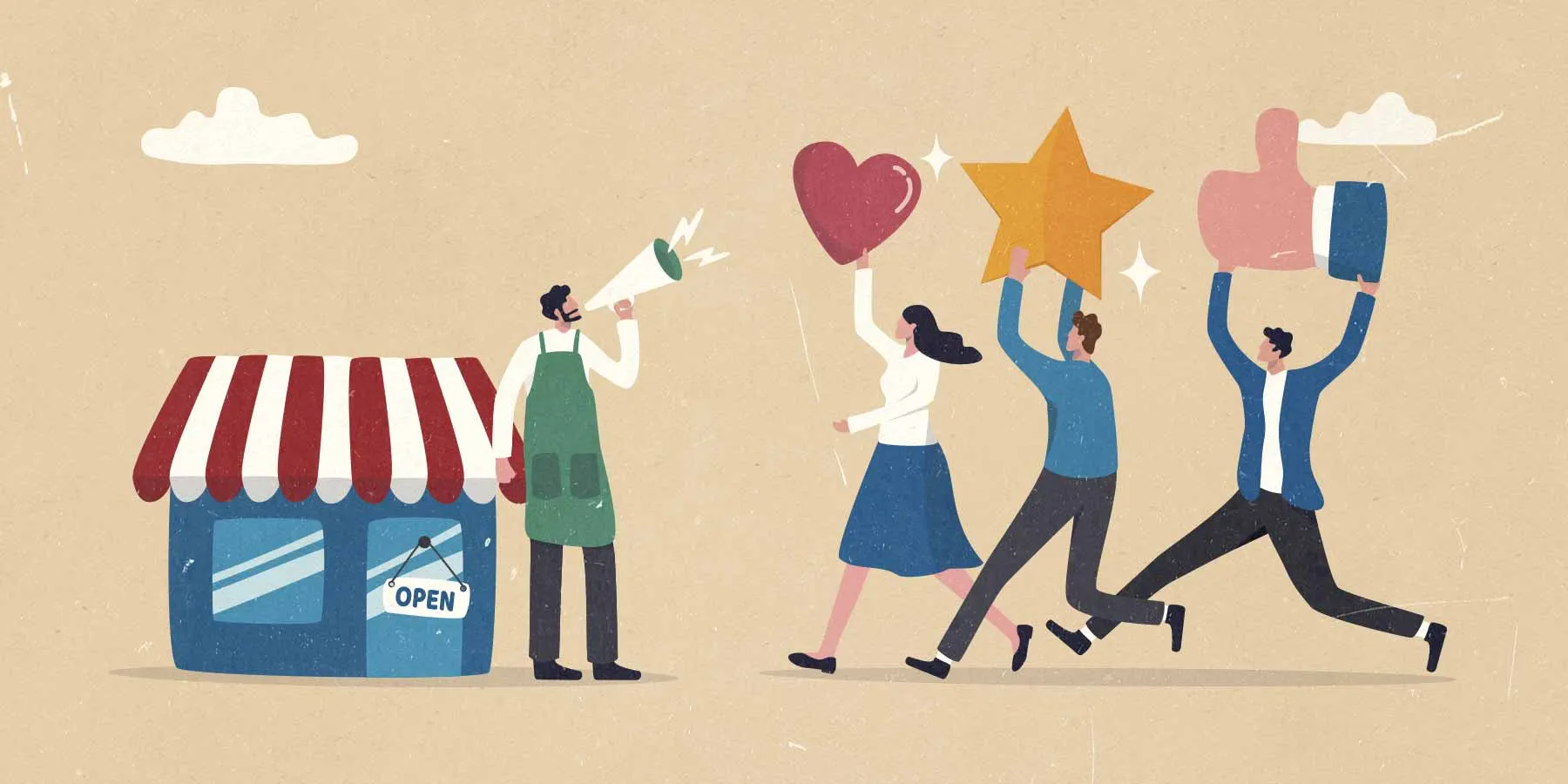
A brand is only as strong as its customer relationships—and one of the most effective ways to build trusting, long-lasting relationships with your customers is to create a top-notch customer loyalty program.
This is particularly true in 2023 as economic uncertainty and layoffs continue to plague businesses around the world. Consumers are on the hunt for deals, which means they’re more inclined than ever to interact with brands that provide true value. A customer loyalty program can help your brand do just that.
Not sure where to start? You’ve come to the right place. Here’s how to create a customer loyalty program your subscribers will love.
Cracking the customer loyalty code
A whopping 72 percent of global customers feel loyalty toward at least one brand or company, and 59 percent of American consumers say that once they’re loyal to a brand, they’re loyal to it for life!
Loyalty programs yield major wins for both brands and their customers, so it’s no wonder why 50 percent of marketers list brand loyalty as one of the top goals of their content marketing strategies. However, only 42 percent of brand executives think their customer loyalty strategies are effective.
Fortunately, cracking the customer loyalty code isn’t as tough as it seems. Here are 10 expert tips to create a loyalty program your customers won’t soon forget—and your business will benefit from.
1. Keep it simple
While you may want to provide several discount options, subscribers are easily overwhelmed by various % or $-off options, special card-holder statuses, or a host of different membership tiers. Consumers respond best to clarity, so when creating your customer loyalty program, be sure to keep it simple.
For example, GAP’s Good Rewards program keeps their strategy clear and concise. In their loyalty welcome message, they explain their system in a single content block: $1 spent = 1 point earned, and 100 points earned = a $1 reward.
A company well-known to have multiple divisions, GAP simplifies the point-earning process further by confirming that points can be earned and redeemed across their entire brand family.

(Source: MailCharts)
2. Provide program education
Loyalty program emails should contain more than just a standalone campaign. After signup, it’s important members are armed with the knowledge they need to make the most of this new relationship.
By sending an email that educates customers on your loyalty program (or better yet, a series of education emails!), brands can elevate the subscriber experience and help build excitement. Program education messages help build trust between brand and subscriber, and when done well, they effectively communicate your business’s investment in the customer experience.
Starbucks, for example, sends a loyalty onboarding series to new members. The third email in the series is a perfect example of going beyond the “how-to-earn” infographic by providing three ways subscribers can maximize “Star” earnings.
This accomplishes two crucial tasks:
- It effectively communicates how subscribers can earn Stars; and
- It primes the subscriber to interact with future messages.
After reading, subscribers will be keenly aware of key events like double Star days, which items yield bonus Stars, and how brand interaction can get them some delicious free coffee.

(Source: MailCharts)
3. Hyper-personalize
Loyalty programs offer many opportunities for brands to target subscribers with tailored and customized promotions. Yet, recent findings indicate only two in 10 members are “very satisfied” with the level of personalization loyalty programs provide. So, where’s the disconnect?
It’s simple: brands aren’t asking customers about their preferences. Subscribers should be given the opportunity to provide a wealth of personal information beyond first name, last name, and email address during the membership registration process. Companies must collect data that’s relevant to their brand or product offerings and actively leverage it to create a personalized experience.
For example, Sephora executes data collection beautifully during the Beauty Insider program registration process. Members can get specific about everything from skin concerns to product ingredient preferences, allowing Sephora to promote products and offers relevant to each individual.
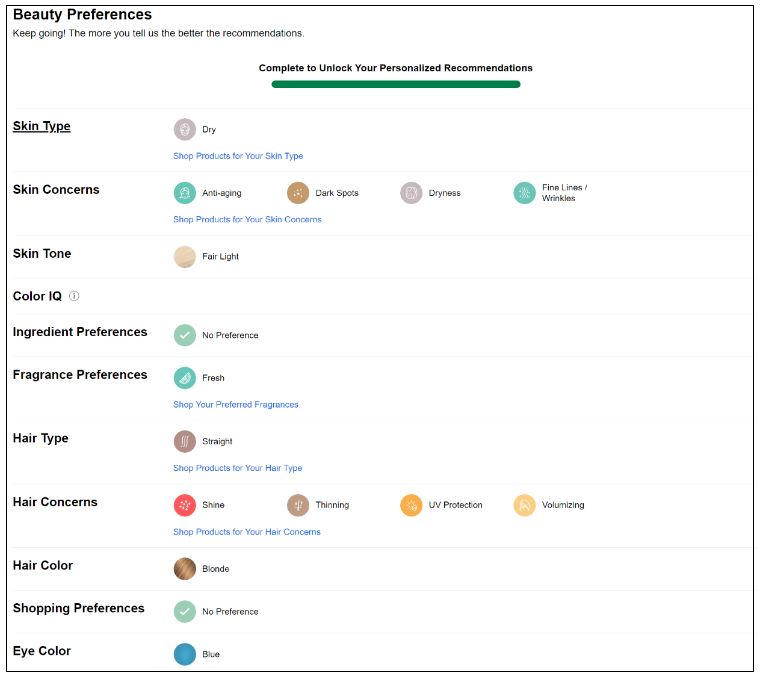
(Source: Sephora)
Members aren’t required to enter these personal details, but if they do, the personalization opportunities are endless.
Beyond tailored product offerings, Sephora leverages the email channel to send roundup or milestone campaigns that are unique to each Insider’s activity.
Milestone messages or progress reports allow brands to reaffirm their relationships with subscribers. These messages help highlight the unique value a brand’s loyalty program provides through fields like points earned, forgotten freebies, and reminders about how long a member has been a part of your program.

(Source, Image 1: MailCharts | Source, Image 2: MailCharts)
4. Offer member-only discounts and perks
This one may seem obvious, but loyalty programs should offer members exclusivity. Customers who’ve joined your loyalty program expect to receive discounts, perks, and offers above what the occasional shopper might receive.
As more and more brands introduce a loyalty component to their marketing programs, subscriber expectations are rising. A $5 or 5% off discount won’t cut it in today’s competitive loyalty landscape!
Bumble and Bumble knows this and sends loyalty emails that highlight the myriad of opportunities for discounts and gifts that come with a membership. They provide a % off discount, free shipping, gifts, as well as both birthday and membership anniversary treats to create tremendous member-only value.
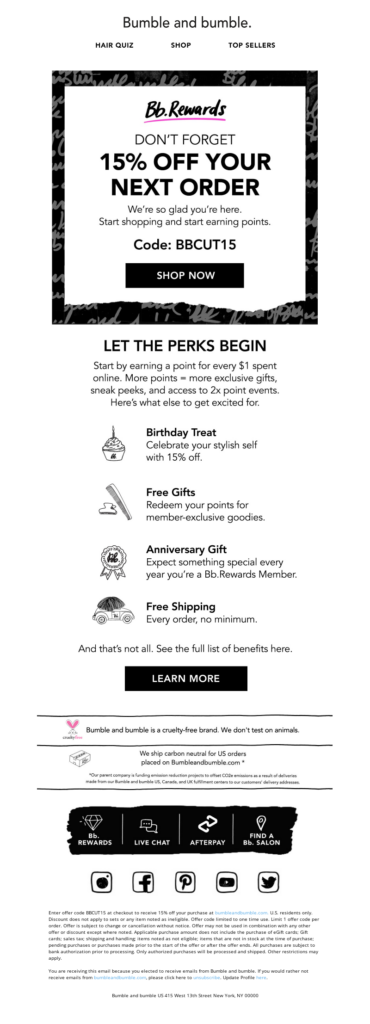
(Source: MailCharts)
5. Have an app (and send emails that promote it!)
In 2023, many major companies have a mobile app customers can use to interact with their brand. Apps have become necessary, especially since 79 percent of Americans indicate they’re more likely to join a reward program that doesn’t require carrying a physical card.
Instead of a loyalty card, brands should provide an app that allows subscribers to embrace a fully-branded experience, track loyalty status and rewards, and make purchases.
Brands often showcase their app in a dedicated content block included in all promotional campaigns. In addition to these regular reminders, brands should send dedicated emails promoting their app.
Pizza Hut does this perfectly for their Hut Rewards program. This email is entirely dedicated to prompting app downloads and displays all the benefits the app provides for loyalty members. Point summaries, redeemable products based on point balances, as well as simple payment and pizza delivery options all work together to create a positive and simple ordering experience for hungry subscribers.

(Source: MailCharts)
6. Gamify!
Gamification is shown to improve a member’s experience with a loyalty program, particularly among Millennials and Gen Z. Eight in 10 loyalty members will engage with game mechanics when present—but only 50 percent of programs employ them today. Email gamification can seem like a major project, but often a simple GIF will do the trick.
We know gamification can help boost email engagement, but it also elevates the subscriber’s overall experience with your program. In a recent study, “enjoys participating” was found to be the number two driver of member satisfaction with a loyalty program. In fact, members who engaged with game mechanics enjoy participating in a program nearly twice as much as those who don’t!
Gwynnie Bee deployed this enticing scratch card email and leverages gamification to build anticipation. The email is dying to be clicked! It’s simple, yet effective in prompting engagement, introduces game mechanics, and promises real rewards. Refer a friend, animated crosswords, slot machines, and other click-to-reveal campaigns all make engaging a positive experience.

(Source: Spiralytics)
7. Send reward status updates
Reward or point status emails serve multiple purposes, beyond just reaching out to your audience at regular intervals. Point balances, reward redemptions, and waiting offers foster good vibes and happy experiences for your audience.
You know what loyalty members don’t like? Expired points. Thirty-one percent of consumers say their biggest issue with loyalty programs is that the rewards expire before they can be used. So, sending point-expiry emails can help curtail subscriber frustration and boost sales through a use-them-or-lose them touchpoint.
Uber’s email with the subject line “Your up to $30 discount has nearly expired” and this Bath & Body Works offer expiry reminder are two great examples of point/reward expiry emails. Final calls and last-chance emails create a sense of urgency that lead to clicks and conversions, all while ensuring subscribers remain informed about their account.
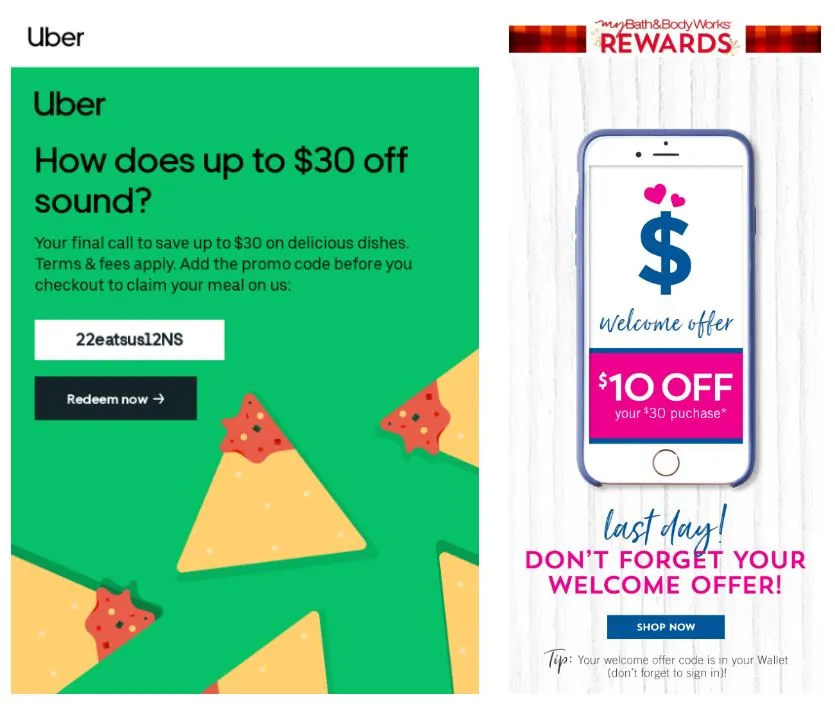
(Source, Image 1: MailCharts | Source, Image 2: MailCharts)
8. Spotlight your partnerships
A loyalty program is an excellent way to highlight brand partnerships. Ideally, these partnerships provide benefits for your brand, your partners, and your customers. Brand partnerships can boost your loyalty program through increased personalization and reciprocal offers, ultimately elevating the subscriber experience. When partnerships are showcased well, brands accomplish more than just a sale—and customers come away with more than just savings.
Tuft & Needle takes the opportunity to both showcase their partnerships and communicate their sustainable ethos in this Giving Tuesday campaign. While today’s consumers are looking for a bargain, they also want to purchase from brands that take a clear stance on social issues. This empathy-based message creates a positive emotional response that helps build trust and brand loyalty.
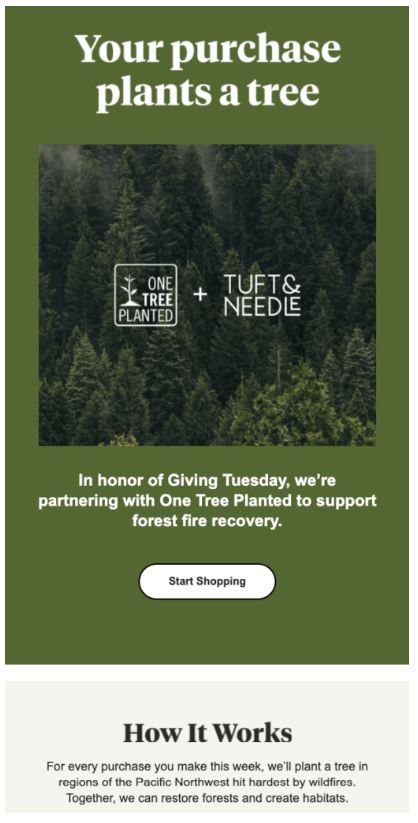
(Source: Drip)
9. Give freebies
Let’s be blunt: the primary driver for loyalty membership is a discount, and who doesn’t love a free gift? A complimentary treat can help affirm a subscriber’s interest in your brand and remind them of the value they find in your products. A freebie might even be the reason a consumer opts to purchase from your brand vs. another, and often presents upsell opportunities.
Consider this example from McDonalds. What are the odds a consumer will visit a location to grab more than a free McMuffin? More free gifts present themselves in this email based on subscriber actions. In many cases, a free gift can provide a brand with an exchange of data or increased brand interaction.
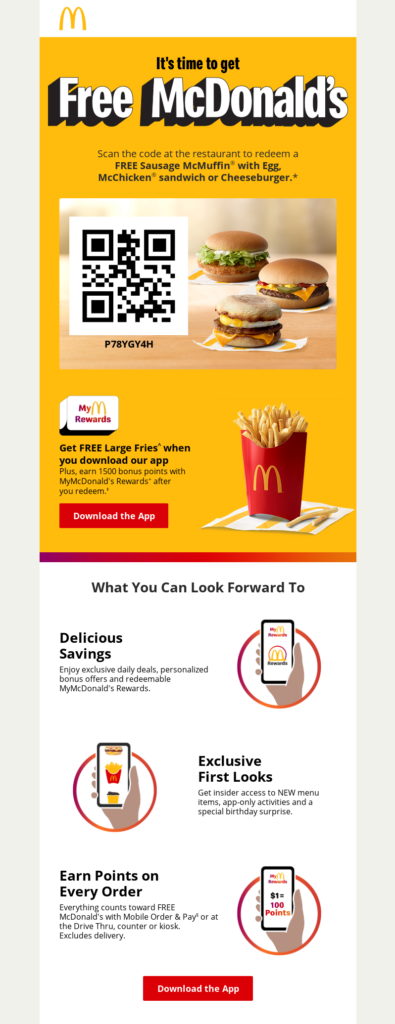
(Source: MailCharts)
10. Solicit feedback
The best brands value their subscribers’ opinions, and opening a dialogue is a great way to ensure your customers’ voices are heard. Through surveys, rating systems, or voting systems, your brand can ensure your loyalty program is meeting subscribers’ needs.
Kate Spade solicits subscriber feedback through a survey email. To prompt subscriber participation, they offer a significant 25% off discount on full-priced items and thank the subscriber in advance for completing the survey. It’s a win-win! Kate Spade receives valuable, actionable feedback and the subscriber feels valued (and can get to shopping). Emails like these ensure your program remains relevant and allows subscribers to feel like they’re a part of your process.
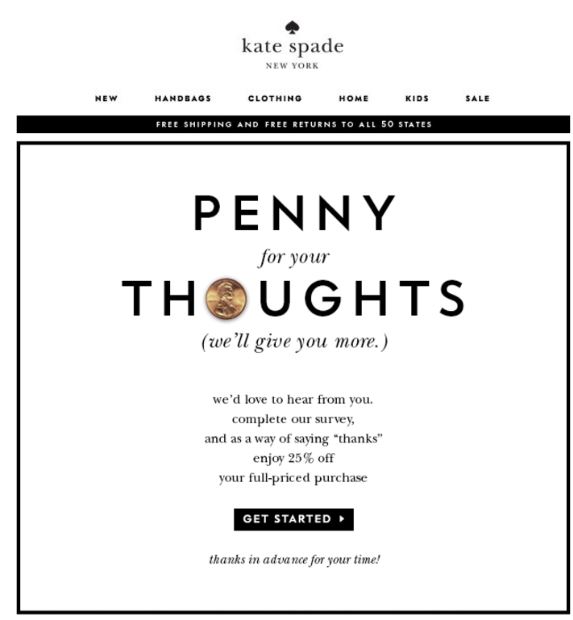
(Source: WordStream)
You’re one step closer to becoming loyalty royalty!
A strong customer loyalty program can set you apart from the competition, strengthen your customer relationships, and do wonders for your bottom line. Following these tips is a great first step towards creating a loyalty program your customers will love.
Looking for a little more inspiration to level-up your loyalty game? Create a free MailCharts account today to start learning from thousands of top brands with successful customer loyalty programs.